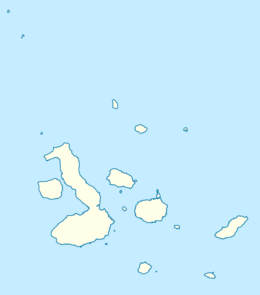Santa Cruz Island (Galápagos)
Topic: Earth
 From HandWiki - Reading time: 4 min
From HandWiki - Reading time: 4 min
| Geography | |
|---|---|
| Location | Pacific Ocean |
| Coordinates | [ ⚑ ] : 0°37′23″S 90°22′06″W / 0.623017°S 90.368254°W |
| Archipelago | Galápagos Islands |
| Area | 986 km2 (381 sq mi) |
| Highest elevation | 864 m (2835 ft)[1] |
| Highest point | Cerro Crocker |
| Administration | |
Ecuador | |
| Demographics | |
| Population | 15,701 (2015) |
Santa Cruz Island (Spanish: Isla Santa Cruz), also known as Indefatigable Island and by other names, is the most populous and second-largest island in the Galápagos Islands, Ecuador. Situated in the middle of the group, Santa Cruz is a shield volcano with an area of 986 km2 (381 sq mi) and a maximum altitude of 864 m (2,835 ft). The seat of Santa Cruz Canton is Puerto Ayora on Santa Cruz. The island's total population is around 18,000 with those living in smaller villages chiefly working in agriculture and cattle raising.
Names
The island's original Spanish name was San Clemente Island[2] (Isla or Ysla San Clemente)[3] in honor of St. Clement. This was changed to Bolivia Island (Isla Bolivia) in honor of the South American revolutionary hero Simón Bolívar upon the islands' annexation by Ecuador in 1832[citation needed] and then to Santa Cruz ([ˈsanta ˈkɾus], "Holy Cross") in reference to the cross upon which Jesus was crucified during the 1892 renaming of the islands upon the quadricentennial of Christopher Columbus's first voyage. It was also sometimes known as Chavez Island (Isla Chávez).[4]
The English pirate William Ambrosia Cowley named the island the Duke of Norfolk's Island in 1684,[5] later shortened to Norfolk Island, in honor of either Henry Howard, 6th Duke of Norfolk, or his son Henry, the 7th Duke of Norfolk, or possibly both.[4] It was later renamed Indefatigable Island in honor of the third-rate ship of the line HMS Indefatigable, which distinguished itself during the Napoleonic Wars and later saw service in the Royal Navy's South America squadron.[4]
Geography
Santa Cruz is an oval-shaped island 32 km (20 mi) long and 40 km (25 mi) wide. It has an area of 986 km2 (381 sq mi) and a maximum altitude of 864 m (2,835 ft).[1][6][7][8] Santa Cruz is the second-largest island after Isabela.
Geology
The island is a shield volcano. Its summit contains a shallow caldera that has been largely buried by youthful pit craters and cinder cones with well-preserved craters. The most recent eruptions may have occurred only a few thousand years ago with the effusion of sparsely vegetated lava flows from vents on the north flank and along the summit fissure.[9] A gigantic lava tube measuring over 2,000 m (6,600 ft) long is a tourist attraction on the island. As a testimony to its volcanic history there are two big holes formed by the collapse of a magma chamber known as "The Twins" (Los Gemelos).[10][11]
Plant life
Tortuga Bay is located on the Santa Cruz Island near Puerto Ayora where fauna such as marine iguanas, birds, Galapagos crabs can be seen. There is also a mangrove where white tip reef sharks and the gigantic Galápagos tortoises can be sighted.[12]
Demographics
Santa Cruz hosts the largest human population in the archipelago at the town of Puerto Ayora, with a total of 18,000 residents on the island.[1]
Points of interest
- Charles Darwin Research Station
- Headquarters of the Galápagos National Park Service
- Lava tunnels
- El Chato and Rancho Primicias Giant Tortoise Reserves
- Itabaca Channel
- Black Turtle Cove
- Cerro Dragón
- Tortuga Bay
- Playa El Garrapatero
- Los Gemelos
- Stand of Scalesia - daisy trees
Sister cities
On June 19, 2002, the cities of Seabrook, Texas and Santa Cruz Island finalized a sister city status during a ceremony at Seabrook City Hall.[13] [14]
References
Citations
- ↑ 1.0 1.1 1.2 "Santa Cruz". Galápagos Conservancy. http://www.galapagos.org/about_galapagos/santa-cruz/. Retrieved 26 September 2012.
- ↑ Kitchin, Thomas (1797), "South America", Kitchin's General Atlas..., London: Laurie & Whittle.
- ↑ De la Fuente, Vicente (1744), Nueva y Correcta Carta del Mar Pacifico ó del Sur... [New and Improved Map of the Pacific or Southern Sea], Madrid.
- ↑ 4.0 4.1 4.2 McEwen (1988), p. 236.
- ↑ McEwen (1988), p. 235.
- ↑ http://m.nzherald.co.nz/travel/news/article.cfm?c_id=7&objectid=11491237 On Santa Cruz, the walkable downtown area of Puerto Ayora is a small strip of hotels, restaurants, tour companies and gift shops.
- ↑ http://www.heraldsun.com.au/leader/news/visit-the-galapagos-islands-but-tread-lightly-on-natures-construction-site/story-fnglekhp-1227463418157 Visit Santa Cruz Island, Galápagos Islands, but tread lightly on "nature's construction site"
- ↑ http://traveller24.news24.com/Explore/Islands/Top-10-islands-number-one-might-surprise-you-20150714 Tortuga Bay Puerto Ayora Galápagos Islands,
- ↑ "Santa Cruz". Smithsonian Institution. https://volcano.si.edu/volcano.cfm?vn=353091.
- ↑ "Pit Craters". 2015. http://worldlandforms.com/landforms/pit-crater/.
- ↑ "Gobernador de Galápagos: Inadmisible cerrar locales". 13 August 2015. http://www.eluniverso.com/noticias/2015/08/13/nota/5065640/gobernador-galapagos-inadmisible-cerrar-locales.
- ↑ http://www.ksl.com/?sid=35827641&nid=1287&title=the-worlds-12-best-spots-for-wild-swimming Las Grietas in Puerto Ayora Galápagos, Ecuador.
- ↑ Evans, Thayer. "Seabrook officials establish family ties with island in the Galápagos" (Archive). Houston Chronicle. Thursday, June 27, 2002. Retrieved on September 6, 2015.
- ↑ Charles Darwin Research Station
Bibliography
- McEwen, Alec (July 1988), "The English Place-Names of the Galápagos", The Geographical Journal, 154, London: Royal Geographical Society, pp. 234–242, doi:10.2307/633849, https://www.jstor.org/stable/633849.
 |
 KSF
KSF


